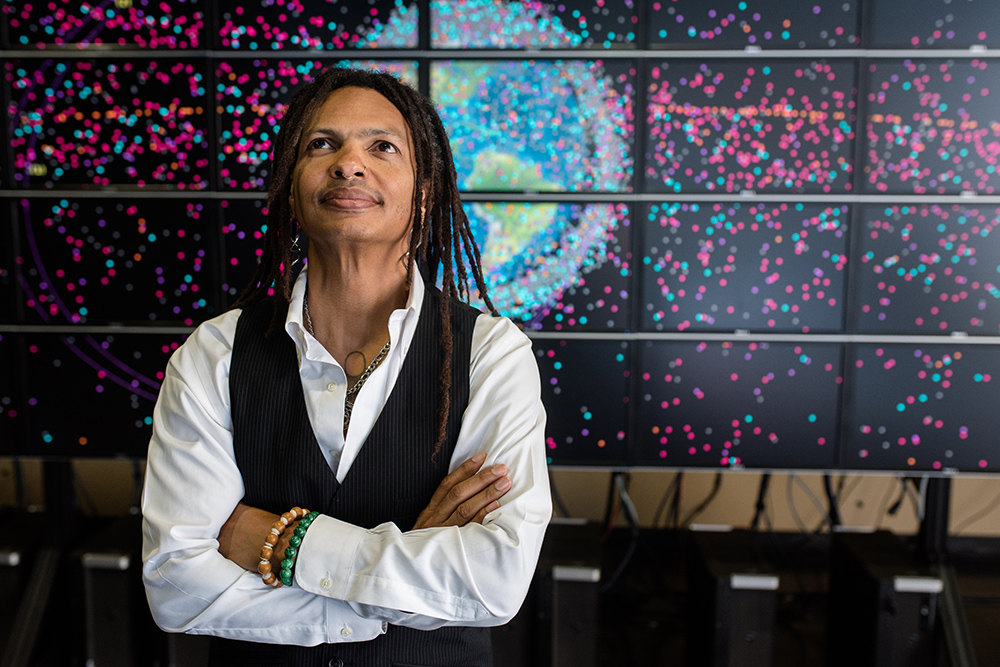For over a decade, Moriba Jah has been on a crusade to inform the public, along with legislators and U.S. STEM leaders, about the growth and consequences of free-floating space debris that continues to pollute our galaxy. Today, as a Texas Engineering faculty member and a subject matter expert invoked by Congress, the National Space Council and the U.S. Air Force, he has been instrumental in helping shape the dialogue around this uncharted extraterrestrial field.
By Moriba Jah
I have always been fascinated by space. I was fortunate enough to get the opportunity to work for NASA fresh out of college, an experience that had a profound impact on my career and my life. And it was there that I started exploring the nature and facets of Earth’s orbital environment. Even then, before companies like SpaceX and Amazon were getting into the commercial space-flight game, I was shocked to find out just how much junk — old and defunct satellites, nuts and bolts, random pieces of spacecraft and so much more — is orbiting our planet and ranging in size from tennis balls to tennis courts.
The increasing number of satellites in orbit, used for everything from weather forecasting to cell-phone signaling, are crucial components to the on-demand information revolution we’re all experiencing, and seemingly benefiting from, today. But you need to know they come at a price. If we don’t address the debris problem, we’ll see more space collisions that could set our space operations, space commerce and space exploration back years. It’s a real issue, and believe it or not, it affects all of us.
We’re estimating that there are nearly 500,000 objects currently orbiting the earth, but the problem is we’re tagging and monitoring only 23,000 of them. The rest are totally unaccounted for, floating out there completely untracked.
So how have we allowed all this debris to accumulate? Essentially, the commercial space sector still operates like the Wild West. Satellites and other spacecraft are launched into orbit by companies operating in a lawless jurisdiction where there is no governing body and, therefore, no official bookkeeper for all of the man-made objects in space.
If we don’t address the debris problem, we’ll see more space collisions that could set our space operations, space commerce and space exploration back years. It’s a real issue, and believe it or not, it affects all of us.”
The bottom line: We cannot turn our solar system into an intergalactic junkyard.
To find a solution, I’ve tapped experts from a variety of fields — teaming up with social scientists and anthropologists as well as engineers and physicists — to develop culturally competent behavioral knowledge graphs in tandem with our predictive and prescriptive analytics to build a system for monitoring or potentially removing space debris.
My goal is to deliver the technology and knowledge needed to create a safe, secure and operationally sustainable space domain. We have a good starting place — our research team in UT’s Advanced Sciences and Technology Research in Astronautics (ASTRIA) program recently invented the ASTRIAGraph, a first-of-its-kind searchable knowledge graph for space traffic monitoring, but we have a long, long way to go. And I invite all you engineers, scientists and space enthusiasts to help me advocate for this important issue and advance the narrative. Let’s solve this problem together.
Moriba Jah is an associate professor in the Department of Aerospace Engineering and Engineering Mechanics and the director of the Advanced Sciences and Technology Research in Astronautics (ASTRIA) program in the Cockrell School of Engineering. He also directs the Computational Astronautical Sciences and Technologies group in the UT Institute for Computational Engineering and Sciences and is a distinguished scholar in UT’s Robert Strauss Center for International Security and Law.
Learn more about astriagraph and track space objects in real time.
